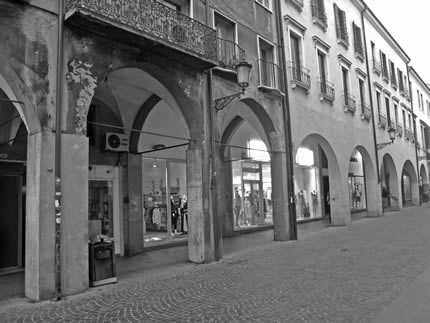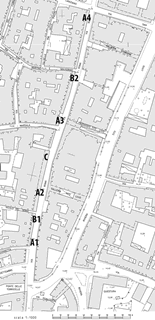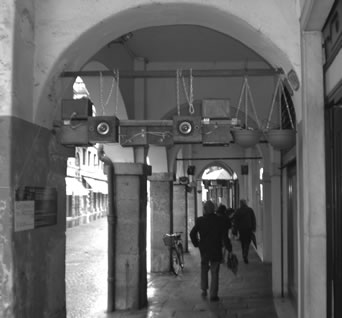Giornata dell'Ascolto, Padua, Italy, 18 May 2008.
Reviewed by Amalia de Götzen
Padua, Italy
Rondò da Passeggio (“Rondeau to go” is an approximate translation into English) is a curious outdoor installation that took place on a single day, 18 May 2008, in Padua, Italy—a rainy day, unfortunately. But Padua is used to frequent rains, and its streets are almost completely accompanied by beautiful porticos, whose function is precisely to keep passers-by dry.

And Rondò da Passeggio was, accordingly, an installation
to sonify the entire 366 yard-long portico of Via Roma, one of the main
pedestrian boulevards of the city. So, in fact, the rain had the effect
of concentrating the passage of intentional listeners and casual strollers
under the porticos, contributing to the widespread success of the event.
Commissioned by Professor Sergio Durante, professor in the Department of Visual Art and Music at the University of Padua, and supported by the city's administration, the Giornata dell'Ascolto (Day of Listening) is an initiative that takes place in downtown Padua on a single day each year.
According to Mr. Durante:
Its theoretical background (here drastically summarized) is that modern culture provides a superabundance of objects (musical objects in our case) but less and less opportunities for appropriate listening conditions. During the day a number of ''different ways of listening" are offered to the citizens (and visitors) of the city to help them retrieve the very sense (and sensibility) of the act of listening. The musical “repertoire” becomes a function of the psychoacoustic and social processes under way rather than an object of fetishism. In order to reach the goal, a relatively broad range of listening experiences are selected, from Persian poetry of the 13th century sung in the 13th-century City Hall building—the Salone della Ragione, to historical Western repertoire, to newly composed music. This was the case for Rondò da Passeggio, which was especially conceived for the listening conditions of a Paduan portico. (electronic mail communication)
Mr. Durante continues:
The idea to produce a multiple linear installation over a stretch of 350 meters is in itself original, but despite that the event reached the national media in the simplified representation of a curiosum, originality per se was not the goal: more important was the choice of collective composition, one that de-empasized the centrality of egoin the compositional processes of the West (a centrality which significantly runs across both ''high" and ''low" musical cultures). On the other hand the project faced and focused some characteristic problems of post-avant-garde music: the listener ''walked through" music rather than joining the crowd at the concert hall or standing in front of one single installation. In this way the listener defined (or rather interacted with) the form of music according to one's walking speed and/or to the special interest for each individual installation, slowing down, speeding up or stopping. At the same time, the installation compelled the casual passer-by to come to terms with sonorities that did not (probably) belong to his or her daily experience. This represents, in itself, a statement within an urban culture (in Padua as anywhere else) that exposes individuals to the daily violence of sounds “not chosen.” Not least, the project posed compositional problems of interrelationship (formal, stylistic, textural) between different parts of the installation. These problems may have been successfully solved (or possibly less than successfully solved); but beyond this point, most important was that the new problems generated new reflections. Hence, the intention to repeat the experience at the next Giornata dell'Ascolto in 2009. (ibid.)
 All
in all, the Rondò da Passeggio was nothing short of
a colossal effort realized with cheap technologies and high-quality passion. Rondò da
Passeggio was conceived by Nicola Bernardini (coordinator of the
installation, and professor of Electronic Music at the Conservatory of
Padua) as a meta-composition of seven different installations distributed
over seven different spots along the portico.
All
in all, the Rondò da Passeggio was nothing short of
a colossal effort realized with cheap technologies and high-quality passion. Rondò da
Passeggio was conceived by Nicola Bernardini (coordinator of the
installation, and professor of Electronic Music at the Conservatory of
Padua) as a meta-composition of seven different installations distributed
over seven different spots along the portico.
The compositions were disposed so as to create the sense of recurring sonic textures while walking along, using a very simple and very classical form, the seven-part rondeau (hence the installation’s name). The idea was that the rondeau form would be perceivable only by walking along the portico. Participating composers included Neil Leonard (faculty of Electronic Music, Berklee College of Music) and Maura Capuzzo (faculty of the Conservatory of Venice), Anthony Baldino (also from Berklee College of Music), Marco Braggion, Gianni Giacomazzo, Raffaele Cipriano, Alberto Schiavo, and Luca Uggias (all from the Conservatory of Padua). They were instructed to compose no less than ten hours of electronic music (that was the planned duration of the installation) with no literal repetitions in it. Furthermore, all compositions were due to start at a precise time (10:00 a.m.) and were supposed to respect (each in its own way) the pausa, or “Sunday rest time,” from 1:00-3:00 p.m. Table 1 summarizes the list of compositions.
Section |
Title |
Composers |
Collaborators |
A1 |
Passeggiando in citt`a tra suoni e rumori |
R. Cipriano |
D. Dassegno, M. Marelli |
B1 |
Guarda dove metti i piedi |
M. Braggion |
D. Corsato, G. Cantore |
A2 |
Walk with newly small hands |
A. Baldino |
M. Vaccarotto, A. Versolatto, M. Petrone |
C |
Uscir ad ascoltar...le stelle |
M. Capuzzo, N. Leonard |
A. Baldino, M. Brigo, F. Morosinotto, S. Putnam, S. Trento |
A3 |
In cammino assieme al L´ogos |
L. Uggias |
M. Pilotto, D. Ceccon |
B2 |
Speranza |
G. Giacomazzo |
P. Duravia, G. Frega, F. Guerra |
A4 |
Natural dialogue |
A. Schiavo |
F. Babolin, F. Marescotti, R. Xotta |
Table 1. The compositions of the Rondò da Passeggio
Each installation has its own distinct character but, given the framework and the constraints, several of them used similar technological tools achieve their final form. Most of them used pre-recorded fragments (of instrumental and vocal music, sounds from the streets, etc.) whose re-composition involved Csound or SuperCollider patches and/or handcrafted editing on audio editing systems like Pro Toolsor Sadie. Some compositions also made use of custom algorithmic software (written in Ruby or in Perl) to pre-process and generate the Csound scores.
 In order to be able to play
back all of the musical material of the seven installations a taskforce
of 23 students from the Sound Engineering program at the Conservatory of
Padua, coordinated by Francesco Morosinotto, created a system of six independent
''sound spots" with a total of 64 custom-designed loudspeakers driven
by some 14 battery-powered T-class digital amplifiers. The loudspeakers
were designed, built, and tested by the students supervised by Professor
Matteo Costa. The loudspeakers used Alpine 5-1/4" SXE-1325S coaxial
drivers powered by Sonic Impact Technologies' T-Amp running the now-famous
Tripath TA2024 chip. Systems were carefully tested to respect Italian
regulations on open-air loudness. The loudspeakers were fitted with hooks
to be hung on the rods that are a structural part of the porticos,
while amplifiers and batteries were camouflaged next to them in unobtrusive
flowerpots.
In order to be able to play
back all of the musical material of the seven installations a taskforce
of 23 students from the Sound Engineering program at the Conservatory of
Padua, coordinated by Francesco Morosinotto, created a system of six independent
''sound spots" with a total of 64 custom-designed loudspeakers driven
by some 14 battery-powered T-class digital amplifiers. The loudspeakers
were designed, built, and tested by the students supervised by Professor
Matteo Costa. The loudspeakers used Alpine 5-1/4" SXE-1325S coaxial
drivers powered by Sonic Impact Technologies' T-Amp running the now-famous
Tripath TA2024 chip. Systems were carefully tested to respect Italian
regulations on open-air loudness. The loudspeakers were fitted with hooks
to be hung on the rods that are a structural part of the porticos,
while amplifiers and batteries were camouflaged next to them in unobtrusive
flowerpots.
The seventh, central spot, which was in the largest part of the portico over the Chiesa dei Servi, was organized as a tryptich of sound collages by Neil Leonard and Maura Capuzzo. This installation required a stronger sound system and was run on three D&B E3 loudspeakers hung 15 feet over the heads of the walking public. Mr. Leonard explained, “I created the sound in collaboration with composer Maura Capuzzo, using sounds of sacred music from around the world. The title, uscir ad ascoltar le stelle..., is derived from the final words of Dante's Inferno: ‘Then we came forth, to see again the stars.’ The title suggests the idea of listening to, and feeling, something immaterial that comes from another world, the world of sacred feelings and attitude. In the case of our installation, the title asks listeners to ‘listen to the sacred world of our collective civilization ...’ It is not a coincidence that we used a text by Dante and a celestial theme. Both Dante Alighieri and Galileo Galilei lived within blocks of the installation.
Following Nicola Bernardini's suggestion, Maura and I used a three-speaker system to create an audio triptych above the entrance to Chiesa di Santa Maria dei Servi. Each speaker played a discrete part of the program. As listeners enter the church for Sunday mass, they experience an audio work linked to hallmarks of Padua's cultural heritage.”
If the objective of the Rondò da Passeggio was to reflect on the sonic fabric that usually accompanies us in our daily walks in the street, to give it some form and meaning, then this installation was a success. People were attracted to listening, to playing the game that music and sounds displaced in space were proposing to them, and to following the form by continuing to walk or stopping out of curiosity about a specific sonic texture. In fact, the event was so much a success that Rondò da Passeggio has been re-engaged for the next Giornata dell'Ascolto in 2009.